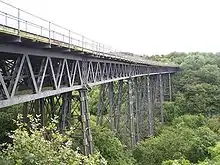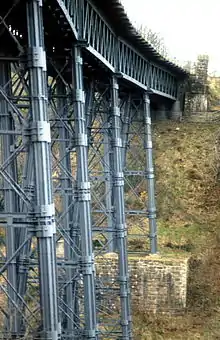Meldon Viaduct
Meldon Viaduct carried the London and South Western Railway (LSWR) across the West Okement River at Meldon (near Okehampton) on Dartmoor in Devon, South West England. The truss bridge, which was constructed from wrought iron and cast iron not stone or brick arches, was built under the direction of the LSWR's chief engineer, WR Galbraith. After taking three years to build, the dual-tracked bridge opened to rail traffic in 1874. Usage was limited to certain classes of locomotive because the viaduct had an axle load limit. Although regular services were withdrawn in 1968, the bridge was used for shunting by a local quarry. In the 1990s the remaining single line was removed after the viaduct was deemed to be too weak to carry rail traffic.
Meldon Viaduct | |
|---|---|
 | |
| Coordinates | 50°42′47″N 4°02′03″W |
| Crosses | West Okement River |
| Heritage status | Scheduled Monument |
| Characteristics | |
| Material | Wrought and cast iron |
| Total length | 165 m (541 ft) |
| Height | 46 m (151 ft) |
| History | |
| Engineering design by | WR Galbraith |
| Opened | 12 October 1874 |
| Closed | 1990 |
| Location | |

| |
The crossing is now used by The Granite Way, a long-distance cycle track across Dartmoor. The viaduct, which is a scheduled monument, is now one of only two such surviving railway bridges in the United Kingdom that uses wrought iron lattice piers to support the cast iron trusses (the other is Bennerley Viaduct between Nottinghamshire and Derbyshire).[nb 1]
History
Dartmoor Railway | |||||||||||||||||||||||||||||||||||||||||||||||||||||||||||||||||||||||||||||||||||||||||||||||||||||||||||||||||||||||||||||
|---|---|---|---|---|---|---|---|---|---|---|---|---|---|---|---|---|---|---|---|---|---|---|---|---|---|---|---|---|---|---|---|---|---|---|---|---|---|---|---|---|---|---|---|---|---|---|---|---|---|---|---|---|---|---|---|---|---|---|---|---|---|---|---|---|---|---|---|---|---|---|---|---|---|---|---|---|---|---|---|---|---|---|---|---|---|---|---|---|---|---|---|---|---|---|---|---|---|---|---|---|---|---|---|---|---|---|---|---|---|---|---|---|---|---|---|---|---|---|---|---|---|---|---|---|---|
| |||||||||||||||||||||||||||||||||||||||||||||||||||||||||||||||||||||||||||||||||||||||||||||||||||||||||||||||||||||||||||||
In the 19th century, the LSWR was in competition with the Great Western Railway (GWR) to provide passenger trains from London to Devon and Cornwall. But as the South Devon Railway, an associate of the GWR, had already built a line from Exeter St Davids to Plymouth along the south coast under the direction of Isambard Kingdom Brunel. The LSWR, and its engineer, William Galbraith, were only left with a route that would have to cross the uplands of Dartmoor.[2]
Work began on Meldon Viaduct in 1871. When it opened on 12 October 1874 it was part of the LSWR's routes to Plymouth and Bude via Okehampton. Originally it carried a single track, part of the Exeter to Plymouth railway of the LSWR, but the track was doubled in 1878 when a steel viaduct of similar design was constructed next to it and the two were joined.[2][3] The construction of the second line was conducted whilst the original line remained open. In order to dispense with the need for high scaffolding, the trestles were erected by means of derricks mounted on the original structure. The trusses were constructed in a railway siding and lifted by means of two heavily-ballasted, rail-mounted cranes that were then pushed onto the original bridge and swung out into position by the cranes. Each truss could be thus installed within around two hours and thirty minutes, meaning that the work could be arranged around the railway timetable to avoid the need to close the line at any stage. The method, devised by engineer T Wrightson and supervised on site by W Jacomb, worked well and the new bridge was complete within 16 weeks of starting work.[4] On 5 May 1931 a carpenter, F. Rook, was killed in an accident whilst replacing timber decking on the down line.[5]
Passenger services on the line were withdrawn in 1968, after which the line reverted to a single track and the viaduct was used predominantly for shunting freight trains serving the ballast quarry at Meldon. In 1970, a road was built across the viaduct to permit lorries access to the Meldon Dam construction site. The bridge was assessed in 1990 as being too weak to carry trains and the rails were removed. Six years later, the viaduct was refurbished and re-opened as part of The Granite Way, a combined cycle and foot path.[2] It is now a scheduled monument.[2][3][6]
The viaduct is now owned by the Meldon Viaduct Company, a not-for-profit organisation set up in February 1999 to safeguard the viaduct.[7]
At various times since the closure of the line, local people and enthusiasts have campaigned for its re-opening, a campaign which gained added prominence in 2014 after severe winter storms severed the Great Western Main Line at Dawlish in February. According to Network Rail, the condition of Meldon Viaduct was a significant obstacle to the re-opening of the line and it would need to be replaced before trains could run on the line.[8][9]
Design

The viaduct is constructed of wrought iron and cast iron, one of two surviving wrought iron truss girder railway bridges in the United Kingdom.[2][10][11] The only other surviving example is Bennerley Viaduct, between Nottinghamshire and Derbyshire.[12] It consists of six warren truss spans, each of 90 feet (27 metres), and is supported by five lattice trestles.[2][10] The original bridge (that now forms part of the up line) was constructed of a pair of trusses at 5 foot (1.5 metres) centres.[10] When the bridge was later widened to allow double track operation, a second structure of almost identical construction was erected 7 feet 6 inches (2.29 metres) from the original bridge with the gap spanned by timber decking.[10][2] The trusses are 9 feet 4 inches (2.84 metres) high and the older trusses are unusual in that the tension (bottom) member is made of plate metal rather than a rolled girder. The trestles vary in height from 48 feet (15 metres) to 120 feet (37 metres) and are constructed of four wrought iron piers supported by horizontal and diagonal bracing.[10] The trestle sections taper inwards from the base and rest on 24 foot (7.3 metres) wide masonry bases.[2]
The viaduct is 163 metres (535 feet) long and, at its highest point, rises 46 metres (151 feet) above the valley. The viaduct has slight curve[nb 2] which, combined with its exposed position, resulted in speed and weight restrictions being applied to trains crossing it. The speed limit was set at 20 miles per hour (32 km/h) in 1927. The trestles were strengthened in 1938 and 1944 in order to allow heavier traffic to use the viaduct during the Second World War, and further strengthening to the trestles was carried out in 1959 and 1960.[2][10][7]
Notes
- The only road bridge in the UK supported by lattice trestles is Ovingham Road Bridge.[1]
- The horizontal radius is 1,980 feet (600 metres)[10]
References
- Rennison, Robert William (1 January 1996). Civil Engineering Heritage: Northern England. London: Thomas Telford Ltd. p. 31. ISBN 0727725181.
- "Meldon Case Study" (PDF). Devon County Council and Dartmoor National Park Authority. Archived from the original (PDF) on 4 March 2014. Retrieved 17 April 2014.
- Historic England. "Meldon viaduct (1002631)". National Heritage List for England. Retrieved 21 April 2014.
- Wrightson, T. "Correspondence: The different modes of erecting iron bridges". Proceedings of the Institution of Civil Engineers. 63 (1881): 213. doi:10.1680/imotp.1881.22142.
- Ministry of Transport (1931). Railway Accidents: Reports by the Inspecting Officers of Railways of Inquiries Into Accidents. p. 30.
- "The Granite Way" (PDF). Devon County Council. 2008. Archived from the original (PDF) on 7 May 2013. Retrieved 21 April 2014.
- "Meldon Viaduct". Engineering Timelines. Retrieved 22 April 2014.
- Roden, Andrew (20 August 2014). "Dawlish Diversion: the main contenders". RAIL. Peterborough: Bauer Consumer Media (755): 72–74. ISSN 0953-4563.
- Modern Railways, September 2014, p. 67.
- Otter, R. A. (1994). Civil Engineering Heritage: Southern England. London: Thomas Telford Ltd. p. 61.
- "History of the use of iron in foundations". Information Resources Library. Institution of Civil Engineers. Archived from the original on 27 April 2014. Retrieved 26 April 2014.
- Biddle, Gordon. Britain's Historic Railway Buildings: A Gazetteer of Structures (Second ed.). Hersham, Surrey: Ian Allan Publishing. pp. 188–189. ISBN 9780711034914.
External links
| Wikimedia Commons has media related to Meldon Viaduct. |